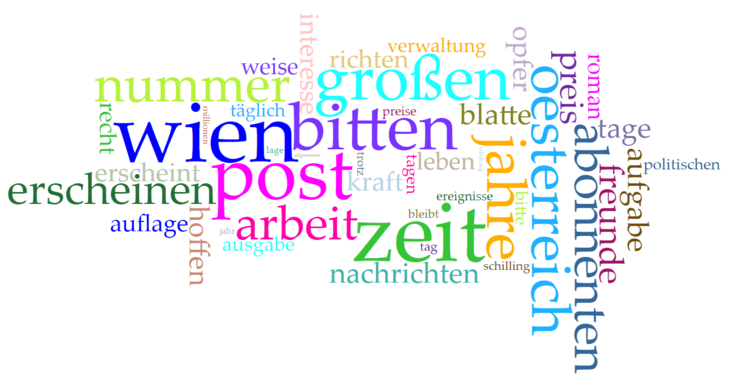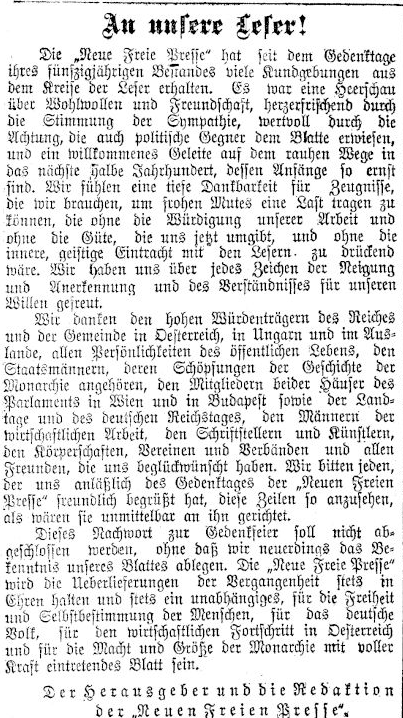Blog posts are written by project team members. Topics range from conferences we attend, musings on current affairs of relevance, internal project findings and news and more succinct content which can be found in our Digital Humanities Case studies or project related publications. Blog posts will mainly be posted in English but will from time to time feature in the language of the project team member’s preference, since we are a multilingual bunch! Happy reading!
„An unsere Leser“: The interaction between newspaper and readership and the journalistic self-image
In the examination of historical newspapers the linear distribution of information rather than a dynamic and mutual communication between writers and readers is usually emphasised. Mostly it is about single articles by editors or messages from news agencies. Therefore the newsroom as a whole and as the central element of a newspaper is often hardly palpable. An investigation of the interaction between the paper, i.e. above all the editorial office as the authoritative unit, on the one hand and the readership on the other enables deep insights into the journalistic backstage. By doing so, various findings on the development of journalism between 1850 and 1950 can be gained. Digital newspaper archives may provide knowledge on how the relation between media production, distribution and reception was conceived. This blog post deals with the question of how newspapers interacted with their readership and what this reveals about the development and the practices of journalism.
Newspapers in the 19th century
With the technical progress and the improvement of the printers in the first half of the 19th century the basis for the proliferation of the press was formed. In the context of the industrial revolution the introduction of the steam-driven rotary press in Philadelphia in 1846 and other techniques had a profound impact on the entire process of newspaper-production. It became quicker, more inexpensive and more efficient. With the rise of alphabetisation and education in society the audience, in turn, increased as well. Due to the wider readership a mass public sphere emerged so that reading newspapers was no longer reserved to the elites and the middle classes (Telesko 2010, p. 228–229).
Along with the technological innovations and the social changes the legal dimension also played a key role in the development of journalism from the 1850s onwards. After the revolutions of 1848, Europe saw a gradual process of liberalisation. The national press laws slowly replaced and abolished restrictions, concessions and other charges and thus paved the way for a boom of the press in the second half of the 19th century. Around 1900, the newspaper was consolidated as the mass medium: It became the political, economic and cultural leading medium and a feature of modern nation-states (Melischek/Seethaler 2019, p. 9; Requate 2013, p. 17). It eventually formed the central sphere for the creation of a political public body, in which the relevant issues of the time could be communicated and debated. Therefore, the historical media landscape and the press with the production, distribution and reception provide a highly complex political, social, economic and technological field.
Interaction between newsroom and readership
In typical mass media such as newspapers the one-sided distribution of information is mostly in the focus of attention. The role of the audience, the readers themselves, however, is widely neglected. In the discourse of media historiography there is often a concentration on political and economic reporting. In addition, local events, sports coverage and sensational messages as well as the large advertisement section belong to the “key elements of the mass press” (Bösch 2019, p. 109). The interaction with the recipients frequently is not regarded. Looking at it, though, enables the interpretation of the social function of newspapers and journalistic practices from the backdrop of technical infrastructures.
In digital newspaper archives the interrelation can be assessed with keywords that include the readership as an addressee. For instance, articles with the phrase “an unsere Leser” (“to our readers”) or “dear readers” (“Liebe Leser” both male and female) contain an explicit steering towards the audience itself. Since newspapers, by nature, address the readers with any featured article, these messages have an extraordinary significance: The newsroom emerges from the background and becomes visible as one unit. With the signing as a sender at the end of the message the editorial office speaks with one voice and directly addresses the audience on its own account. Thereby certain occasions and backgrounds manifest themselves, giving insight into the journalistic meta-level and the development of media.
The keyword search of the phrase “an unsere Leser” leads to 7,630 hits in the digital archive ANNO of the Austrian national library. As a consequence a corpus with a selection of articles between 1850 and 1950 was manually compiled. The articles were chosen based on their relevance for journalistic meta-level. Thus over 220 results from 26 different Austrian newspapers were used. There was a focus on the Arbeiter-Zeitung, the Illustrierte Kronen Zeitung as well as the Neue Freie Presse. A glance at the word cloud (figure 1) of the corpus shows the most frequently used terms and gives a first impression of the most dominant words and intentions behind the messages.

The frequency of many of these terms is an interesting starting point for further investigation with the keywords in context. The relevance of “wien” (“Vienna”) emphasises the significance of the city as the political and journalistic centre in Austria, hosting many editorial offices. For that reason there are many references. Based on this figure other visualisations can be used that give an overview of the usage of the phrase. For instance, Voyant Tools or KH Coder offer numerous tools and graphic descriptions. Various interesting aspects about journalistic practices come to the surface, such as the self-image of the paper.
Year after year: the self-identity of newspapers
The consideration of the term “jahre” (“years”) as a keyword in context shows that the phrase “an unsere Leser” was often used with reference to a year or years. The time of the mentioning mostly was on the threshold of a new year. The editorial office turned to the audience with a kind of annual balance, summarizing the past year and looking ahead. The message served the construction of a relationship with the readership and of a “mutual” past and future. Thus it was especially important for binding the readers to the paper and for fostering loyalty. For instance, the Arbeiter-Zeitung wrote on 30 December 1898 in the morning paper on page 1 under the title “An unsere Leser”.
„Arbeiter, Parteigenossen! Ein neues Jahr beginnt und mit ihm neuer Kampf. Düster und unsicher ist der Blick in die Zukunft dieses Landes, […]. Unser Weg ist schwer, aber die Arbeiter-Zeitung wird ihn furchtlos wie bisher zu gehen wissen, wenn ihr uns zur Seite steht und euer Blatt kräftig fördert.“
Translation:
„Workers, party comrades! A new year begins and with it a new struggle. Somber and uncertain is the look into the future of this country, […]. Our path is hard, but the Arbeiter-Zeitung will fearlessly continue it, if you are on our side and strongly support our paper.”
Along with the outline of the major challenges there is also an overview of the impending serial publications of novels and novellas. As a part of the feuilleton these had an essential role. In this preview they function as a “teaser” in order to spark an interest and motivate the readers to buy the paper in the following months. At the end of the article the editorial office is featured as the sender and appeals to the readers to support the common cause: the “big, global fight for liberation of the proletariat”. Moreover, the readership is requested to advertise for “your paper”. Messages like these for the changing of the year can be found quite often, e.g. in the Morgen-Post, in Die Presse or the Wiener Allgemeine Zeitung. Often times they are accompanied by reminders to prolong the subscription or by information on price changes.
Furthermore in the Neue Freie Presse an interesting phenomenon can be identified, which is also indicative of the journalistic self-image. Because in the first issue of the foundation of the paper on 1 September 1864, the two former editors of Die Presse and now editors-in-chief of the new paper, Michael Etienne and Max Friedländer, addressed the readers on the cover page. There they outlined their motivations and their mission, as a kind of mission statement, and shared it with the readers. Over the course of several decades the foundation date of the newspaper became a major focal point and an occasion for self-reflection and self-representation. The editorial office directly wrote to the readership on the paper’s 5th, 25th, 30th and 50th anniversary and reflected on the meaning of the Neue Freie Presse. In an afterword to the “memorial day of its 50th jubilee” the editors published a note on 6 September 1914:
„Die ‚Neue Freie Presse’ wird die Ueberlieferungen der Vergangenheit stets in Ehren halten und stets ein unabhängiges, für die Freiheit und Selbstbestimmung der Menschen, für das deutsche Volk, für den wirtschaftlichen Fortschritt in Oesterreich und für die Macht und Größe der Monarchie mit voller Kraft eintretendes Blatt sein.“
Translation:
„The ‚Neue Freie Presse‘ will always honour the traditions of the past and will forever remain a paper that fights for the independence and autonomy of the people, for the German people, for the economic progress in Austria and for the power and greatness of the monarchy.”

The recollection to the past, the reinforcement of the independence and the reference to their own values emphasise the self-image and the worldview of the paper. The recurring and repeated link to the foundation created a culture of remembrance of the business itself. As part of the interaction with the readership, this provided a vital strategy for binding them to the newspaper over a longer period. It also expresses a discursive construction of a mutual history and relationship. In particular, the expression of the self-understanding is essential for the reader-loyalty and shows up the political and ideological positioning in the journalistic spectrum.
Conclusion
To sum up, the phrase „an unsere Leser” (“to our readers”) was a relevant message for the editorial office, the publishers or the administration of historical newspapers. As numerous examples indicate, the interaction between the newsroom and the readership was a central part of the newspaper. The occasion was quite often the communication of the individual self-image or worldview as well as the formulation of a certain mission. Ultimately, a main goal was the creation of a feeling of closeness and the consolidation of the loyalty to the paper itself. Digital newspaper archives thus provide special insights into journalistic practices and strategies of the newsroom and the role of interaction with the audience.
Newspaper resources
References
Bösch, Frank (2019): Mediengeschichte. Vom asiatischen Buchdruck zum Computer, Frankfurt-New York (2nd edition).
Melischek, Gabriele/Seethaler, Josef (2019): Die österreichische Tagespresse der Ersten Republik, Matthias Karmasin/Christian Oggolder (eds.), Österreichische Mediengeschichte. Band 2: Von Massenmedien zu sozialen Medien (1918 bis heute), Wiesbaden, S. 7–36.
Requate, Jörg (2009): Einleitung, in: Jörg Requate (ed.), Das 19. Jahrhundert als Mediengesellschaft, München, p. 7–18.
Telesko, Werner (2010): Das 19. Jahrhundert. Eine Epoche und ihre Medien, Wien-Köln-Weimar.